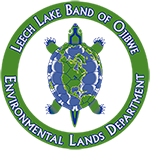 Fish Consumption
Fish Consumption
TOPICS:
1. Bioacculmative Contaminants
2. Leech Lake Fish Tissue Mercury Studies
3. Persistant Organic Pollutants (POP)
4. Leech Lake Fish Tissue Mercury Studies for POP
5. Links for Local Fish Consumption Advisories
1. Bioaccumulative Contaminants:
Mercury, PCBs, Dioxins and DDT
Bioaccumulative chemical contaminants accumulate in the tissues of aquatic organisms at concentrations many times higher than concentrations in the water. Bioaccumulative chemical contaminants can persist for relatively long periods in sediments, where bottom-dwelling organisms that are low in the food chain can accumulate them and pass them up the food chain to fish. Concentrations of bioaccumulative contaminants in the tissues of aquatic organisms may increase at each level of the food chain. As a result, top predators in a food chain, such as largemouth bass or walleye, may have concentrations of bioaccumulative contaminants in their tissues a million times higher than the concentrations found in the waterbodies.
Mercury
Mercury is a highly persistent toxin that affects the brain, spinal cord and nervous system, kidney and other organs. Mercury contamination is in all fish because of airborne contaminants falling into our lakes. About 70% of mercury in the air is the result of emissions from coal combustion, mining, incineration of mercury-containing products and other human sources. Once mercury lands into a lake, it changes form into methyl mercury and then enters the food chain at the lowest level eventually reaching humans. The problem with mercury is that over time, fish accumulate relatively high mercury concentrations. Prolong exposure to mercury can damage your kidneys and nervous system. Young children, developing fetuses and breast-fed babies are at most risk, because small amounts of mercury can affect a child's behavior and lead to learning difficulties.
What can you do about mercury contamination? Well, mercury cannot be removed through cooking or cleaning because mercury is found in the flesh (muscle) of the fish, although you can choose what kind of fish you eat and how often. For example, eat smaller younger fish, eat more panfish (sunfish and crappies) and fewer predator fish (walleyes and northern pike). Also large fish, such as, walleye and northern pike tend to contain more mercury than fish such as whitefish and suckers.
The cycle of mercury in nature is complex. This illustration summarizes how methylmercury accumulates at the higher levels of the food chain and becomes concentrated in fish and animals that eat fish.
1. Methylmercury in the water and sediment is taken up by tiny animals and plants known as plankton.
2. Minnows and juvenile fish eat large quantities of plankton over time.
3. Larger predatory fish consume many smaller fish, accumulating methylmercury in their tissues. The older and larger the fish, the greater the potential for high mercury levels in their bodies.
4. Fish are caught and eaten by humans and animals, causing methylmercury to accumulate in human tissues.
2. Leech Lake Fish Tissue Studies in Mercury
Current and past studies have been conducted for mercury. Some of the lakes sampled include: Bowstring lake (2001)- walleye, northern pike, tullibee, perch pan fish and sucker; Leech lake (2002)- walleye, northern pike, whitefish, perch pan fish and sucker; Steamboat lake (2003)- walleye, northern pike, whitefish, perch and sucker; Big lake (2004)- northern pike, whitefish, perch pan fish and sucker; Portage (2005)- walleye, tullibee, perch pan fish and sucker and Sixmile (2006)- walleye, tullibee, perch pan fish and sucker.
3. Persistent Organic Pollutants
Dioxins and PCBs are all persistent organic pollutants known to be in Leech Lake Reservation Lakes. Dioxins are produced in small concentrations when organic material is burned in the presence of chlorine, so they are widely produced in many contexts, such as, coal fired ultities, burning treated wood and diesel trucks. Dioxin enters the general population almost exclusively from ingestion of food, specifically through the consumption of fish, meat, and dairy products. Dioxins build up primarily in fatty tissues over time (bioaccumulate), so even small exposures may eventually reach dangerous levels. PCBs are man-made substances that were once used in electrical transformers, carbonless papers and hydraulic fluids. PCBs were banned in 1976, but they are still found in the environment, especially in the Great Lakes and major rivers, such as, the Mississippi River.
The more oily fish, such as, whitefish, tullibees and suckers tend to contain more PCBs and dioxins. However, PCBs, can be reduced by removing the fat when you clean and cook fish. Typically PCBs and dioxins accumulate in fat tissue compared to mercury which is stored in the flesh (muscle) of the fish.
4. Leech Lake Persistent Organic Pollutant Tissue Surveys
In addition, a persistent organic pollutant survey was conducted in 2002. Fish were taken from Leech Lake (whitefish, walleye, northern pike and perch pan fish; Winnibigoshish Lake (Tullibee, walleye, northern pike, perch pan fish; Bowstring Lake (Tullibee, walleye, northern pike, perch pan fish; Sixmile (Tullibee, walleye, northern pike, perch pan fish); Round Lake (walleye, northern pike, perch pan fish); and Big Lake (walleye, northern pike, perch pan fish and tullibee). Moreover, organic contaminant studies in perch pan fish also have been conducted on Pike Bay, Cass Lake and Ball Club lake in 2002.
Additional Information
Leech Lake Fish Advisory Chart (coming soon)
Mercury on tribal lands - PowerPoint Document
5. Links
Local Fish consumption Advisories:
Cass Lake & Pike Bay Fish Consumption Advisory (2002)
Click to View/Print
Main MN Dept. of Health Link:
http://www.health.state.mn.us/divs/eh/fish/index.html
Main lakes: Leech Lake http://www.dnr.state.mn.us/lakefind/fca/report.html?downum=11020300
Steamboat Lake
http://www.dnr.state.mn.us/lakefind/fca/report.html?downum=11050400
Winnibigoshish Lake
http://www.dnr.state.mn.us/lakefind/fca/report.html?downum=11014700
Cass Lake
http://www.dnr.state.mn.us/lakefind/fca/report.html?downum=04003000
Pike Bay
http://www.dnr.state.mn.us/lakefind/fca/report.html?downum=11041500
Big Wolf
http://www.dnr.state.mn.us/lakefind/fca/report.html?downum=04007900
Andrusia Lake
http://www.dnr.state.mn.us/lakefind/fca/report.html?downum=04003800
Bowstring Lake
http://www.dnr.state.mn.us/lakefind/fca/report.html?downum=31081300
Sand Lake
http://www.dnr.state.mn.us/lakefind/fca/report.html?downum=31082600
Ball Club Lake
http://www.dnr.state.mn.us/lakefind/fca/report.html?downum=31081200
Kitchi Lake
http://www.dnr.state.mn.us/lakefind/fca/report.html?downum=04000700
Big Lake
http://www.dnr.state.mn.us/lakefind/fca/report.html?downum=04004900
Contact Us
(218) 335-7400 DRM
| Name | Title | Phone |
|---|---|---|
| Brown, Levi | Environmental Director | 335-7417 |
| Harper, Jeff | Water Resources Program Manager | 335-7415 |















 Division of Resource Management
Division of Resource Management